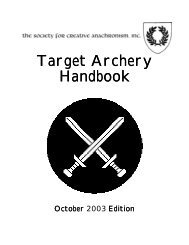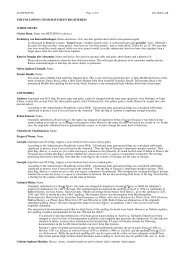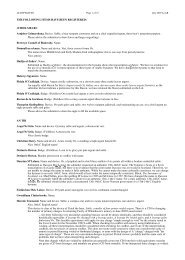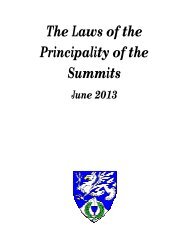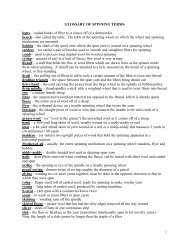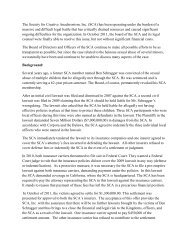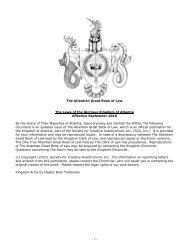The Standards for Evaluation of Names and Armory - SCA Heraldry
The Standards for Evaluation of Names and Armory - SCA Heraldry
The Standards for Evaluation of Names and Armory - SCA Heraldry
Create successful ePaper yourself
Turn your PDF publications into a flip-book with our unique Google optimized e-Paper software.
<strong>The</strong> <strong>St<strong>and</strong>ards</strong> <strong>for</strong> <strong>Evaluation</strong> <strong>of</strong> <strong>Names</strong> <strong>and</strong> <strong>Armory</strong>:<strong>The</strong> Rules <strong>for</strong> Submissions• other divisions into four equal parts(may have substantial difference between themselves, if they share no lines in common, such asper pale <strong>and</strong> per chevron compared to per fess <strong>and</strong> per bend sinister)• party <strong>of</strong> six• checky• lozengy <strong>and</strong> all other grid-like partitions (such as barry bendy <strong>and</strong> per pale <strong>and</strong> chevronelly)2. Substantial Change <strong>of</strong> Tincture: If the field <strong>of</strong> a new field-primary submission has no tinctures incommon with the field <strong>of</strong> a protected piece <strong>of</strong> armory, they do not conflict. If a new submission with a fielddivided into two sections, three sections, quarterly, or per saltire has changed the tincture <strong>of</strong> each section <strong>of</strong>that field <strong>and</strong> each has at least one tincture on the field that the other does not, the two are substantiallydifferent <strong>and</strong> do not conflict.Furs are considered to be different from one another <strong>and</strong> from their base tincture. <strong>The</strong> addition <strong>of</strong> a fieldtreatment is also a change <strong>of</strong> tincture.For example, Per chevron azure <strong>and</strong> gules <strong>and</strong> Per chevron sable <strong>and</strong> argent do not conflict, because thefields do not share a tincture. Per pale azure <strong>and</strong> gules <strong>and</strong> Per pale gules <strong>and</strong> argent do not conflict,because they are a type <strong>of</strong> field division with two sections, they have changed the tincture <strong>of</strong> each section,<strong>and</strong> each one has a tincture that differs. Similarly, Quarterly azure <strong>and</strong> gules, a bordure argent <strong>and</strong>Quarterly gules <strong>and</strong> Or a bordure argent do not conflict because they are four-section field divisions, theyhave changed the tincture <strong>of</strong> each section, <strong>and</strong> they each have a tincture that differs - the tincture <strong>of</strong> thebordure is not relevant.In contrast, Per pale azure <strong>and</strong> gules is not clear <strong>of</strong> conflict under this rule with Per pale gules <strong>and</strong> azurebecause neither has a tincture the other does not. Barry bendy vert <strong>and</strong> argent is not clear <strong>of</strong> conflict underthis rule with Barry bendy sinister vert <strong>and</strong> Or because both share a tincture in the same section. Paly azure<strong>and</strong> gules is not clear <strong>of</strong> conflict under this rule with Paly gules <strong>and</strong> argent because they are divided intomultiple sections (such that the order <strong>of</strong> the tinctures makes little visual difference) <strong>and</strong> they share atincture. This is true even <strong>for</strong> Paly <strong>of</strong> four parts.Per bend ermine <strong>and</strong> azure is substantially different from Per bend erminois <strong>and</strong> gules <strong>and</strong> from Per bendargent <strong>and</strong> sable. Per fess argent <strong>and</strong> gules is substantially different from Per fess argent masoned gules<strong>and</strong> sable. In each case, the two pieces <strong>of</strong> armory have no tinctures in common.G. <strong>St<strong>and</strong>ards</strong> <strong>for</strong> Difference through Two Distinct Changes: A distinct change (DC) is a change that wasgenerally used as a cadency step or is similar in visual weight <strong>and</strong> meaning to changes that were used ascadency steps. Any new design which has at least two distinct changes from a protected design does notconflict with it. In older precedent, two elements which have a distinct change between them were sometimessaid to be significantly different, or that there was a CD between them; in current precedent they are said to bedistinctly changed, or that there is a DC between them. <strong>The</strong> types <strong>of</strong> changes which are substantially differentwhen applied to primary charges under A.5.E above generally count as a distinct change when applied toother charge groups.When comparing two armorial designs, the procedures outlined in A.5.C above should be followed.For any given section below, only one distinct change (DC) can be derived from one type <strong>of</strong> change to asingle charge group, no matter how radical the changes. Multiple distinct changes (DCs) may be derivedfrom multiple types <strong>of</strong> changes to a single charge group or by changes to multiple charge groups. In general,a change to half the charge group (as defined in A.5.C.2.d above) is sufficient <strong>for</strong> a distinct change. However,<strong>for</strong> a half which is defined as a special case in A.5.C.2.d above a maximum <strong>of</strong> one distinct change can bederived from all changes to that half, no matter how radical the changes.<strong>St<strong>and</strong>ards</strong> <strong>for</strong> <strong>Evaluation</strong> <strong>of</strong> <strong>Names</strong> <strong>and</strong> <strong>Armory</strong> – April 29, 2012 - Page 59 <strong>of</strong> 73



